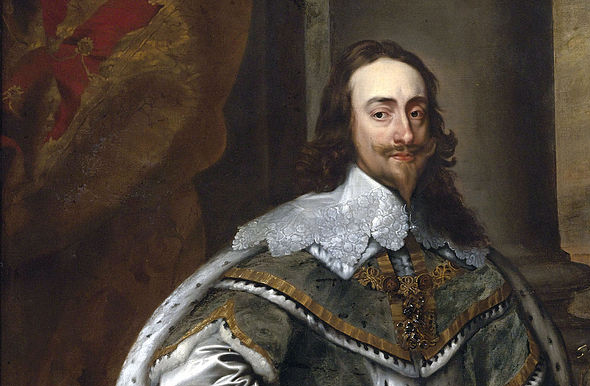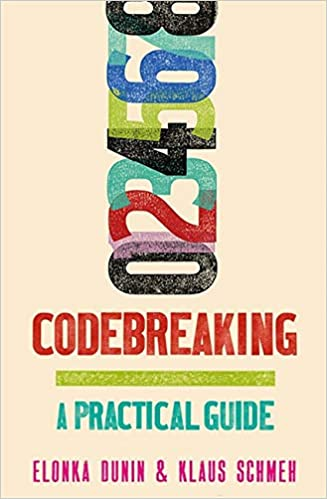In 1648, English king Charles I wrote four encrypted letters while in captivity on the Isle of Wight. Can a reader break these cryptograms?
Let me first proudly announce that the cover design of my next book, Codebreaking: A Practical Guide (co-written with Elonka Dunin), has now been published:
Many readers of this blog have contributed to this work, including Bill Briere, Magnus Ekhall, Thomas Ernst, Bernhard Esslinger, Dave Oranchak, Tobias Schrödel, Gerhard Strasser, Satoshi Tomokiyo, Paolo Bonavoglia, Thomas Bosbach, Jew-Lee Lann-Briere, Tony Gaffney, Jim Gillogly, Karsten Hansky, Nils Kopal, George Lasry, Richard SantaColoma, and Bart Wenmeckers. Publication is scheduled for November.
Unsolved cryptogram pages
One of the topics covered in this book are unsolved cryptograms. Most readers of this blog certainly know my The Top 50 unsolved encrypted messages. My co-author Elonka Dunin has a list of famous unvolved ciphertexts on her website, too.
If you are interested in unsolved machine cryptograms, check Jean-François Bouchaudy’s web-page (thanks to George Lasry for the hint).
There’s yet another page about unsolved cryptograms, and I wonder why I have never mentioned it on this blog before: Satoshi Tomokiyo’s Unsolved Historical Ciphers section, which is a part of the highly recommended Cryptiana site (also maintained by Satoshi).
Satoshi, who lives in Yokohama, Japan, was one of the proof-readers of my aforementioned codebreaking book. Elonka and I were quite impressed by his expertise in codes, nomenclators, homophonic ciphers and other encryption methods, which led to an extremely valuable feedback he provided us. And no, I don’t think that Satoshi Tomokiyo is identical with the mysterious Satoshi Nakamoto, inventor of BitCoin, though the two have the same first name.
On his Unsolved Historical Ciphers page, Satoshi writes:
Several well-known unsolved ciphers such as the Voynich Manuscript, Beale ciphers, Dorabella cipher, etc. have been attracting attention of the worldwide cryptologic community […], but historical archives (and other publications) contain many other pieces written in codes and ciphers that remain unsolved. The following lists some of such pieces in the hope that only a fraction of the efforts directed to major cryptologic puzzles might contribute to the solution of these small puzzles. (Recently broken ciphers are also listed.) The reader is kindly asked to provide information if he/she knows or attains decipherment of any of these.
Satoshi’s list contains some 60 entries, about 20 of which are solved. Some of these messages have been covered on this blog before, for instance an encoded telegram from the British consulate in Lüderitz (then German South-West Africa) to the Foreign Office in London and an unsolved Enigma message sent in 1945.
Charles I’s encrypted letters
On Satoshi’s list, there is a series of four messages that looks especially interesting to me: the letters written by Charles I of England (1600-1649) during his captivity on the Isle of Wight in the year 1648. Shortly after, in January 1649, Charles I was executed.
Details about these letters are available here on a separate page Satoshi created (the messages in question are listed as number 4).
Here’s a transcript of the first letter Charles I wrote:
Z: / I am verrie well satisfied with the discreete & carefull account that you have given me of my Business & particularly that you did 208 343 294 74 9 45 86 18 96 1 40 82 395 380 2 20 3 230 388 45 36 4 11 7 43 31 62 270 248 now it will be 36 19 5 32 39 12 37 8 97 I desyre you to enquyre whether or not 396 213 355 204 28 21 363 257 64 36 46 9 32 395 42 35 14 53 38 23 18 50 88 but for this 236 308 267 356 282 96 62 86 205 17 356 66 50 97 206 231 248 38 1 20 2 230 388 46 36 257 208 86 25 268 8 3 50 240 6 51 248 416 303 78 9 68 45 in the meane Tyme lett me know 379 4 28 5 348 354 the …. 206 18 So I rest
Your asseured Frend,
J.
According to Satoshi’s page, this letter was shown in the third episode of the BBC documentary series, Castles: Britains Fortified History. To my regret, this series appears not to be available online.
My guess is that Charles I’s letters were encrypted with a nomenclator, which makes them hard to break. If a reader knows more about this crypto mystery or even can solve it, please let me know.
Follow @KlausSchmeh
Further reading: A cipher device used by king Henry II
Linkedin: https://www.linkedin.com/groups/13501820
Facebook: https://www.facebook.com/groups/763282653806483/





Kommentare (14)